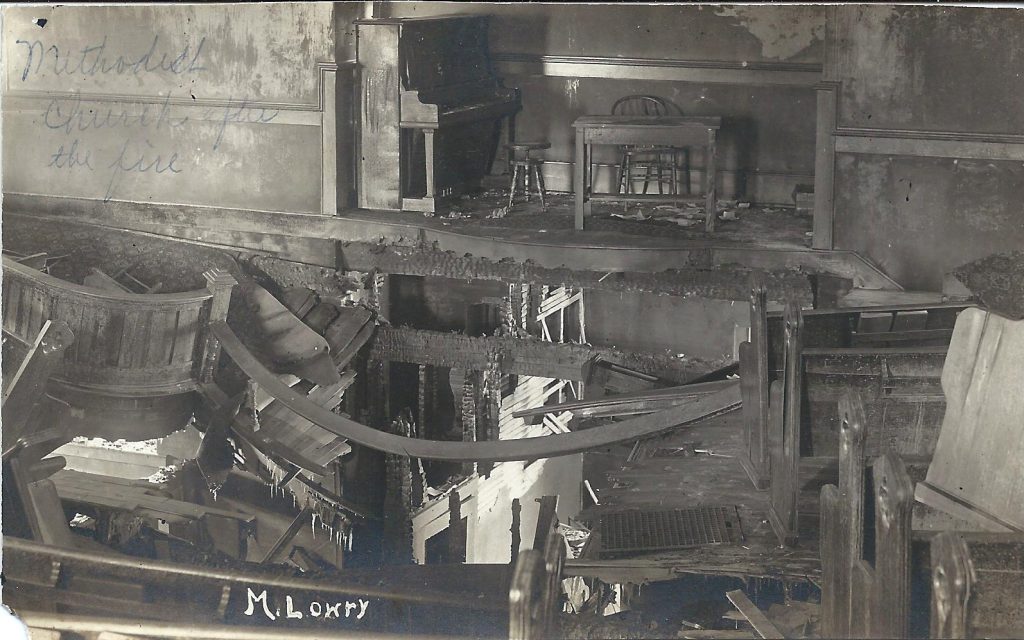
Long, cold snowy winters are nothing new to the residents of the Marion area. From the earliest lumbering days, when a good covering of snow was an advantage in the moving of logs, to the beginnings of the snowmobile days, Marionites have cursed or reveled in the white stuff. Mostly, they have simply dealt with it as best they could and tossed another log on the fire.
Fire is always a threat although seemingly more so in the winter months. Property loss from fire was a common threat in the earliest years in our town. The pages of the Marion Dispatch/Press often reported chimney fires, and worse. Many homes had a permanent ladder on the roof leading to the chimney. Our town, like our neighbors, has been shaped and changed by flames.
Marion has seen several massive conflagrations. Many of the Main Street buildings to survive the Great Fire of 1904, that claimed more than twenty-two buildings, eventually went the way of the flame. Buildings spared in 1904 were wiped out in a matter of hours in a 1908 fire that claimed six businesses on the north side of Main between Pickard and Carland. In 1909 Christopher Clark’s original planning mill, located on the river just below the dam, (at the site of the historical marker) was lost to flames.
In 1914 more early buildings on the south side of Main were lost. George Gray, Furniture and Undertaking, was burned out for the fourth time. He took some solace and pride in the fact that none of the fires originated in his business. The Game Brothers Meat Market also suffered a string of fires in their various locations.
March of 1916 saw flames gutting the interior of the newly built Methodist Church. Frozen water mains and hoses hampered firefighters but the brick building was saved.
Through the years various small fires occurred at the home of Marion Clark. In 1904 she successfully smothered a chimney fire with blankets and rugs. The damage was slight. In 1914 a larger fire did considerable damage, gutting a portion of the home. Located on North Clark Street, the venerable Clark house overlooked the pond. The large home was built in 1884, adding to the original 1875 log structure, and was completely lost to flames in 1945. No doubt, a good deal of early Marion history was lost in that fire.
The Marion House, an early building and well known landmark, was lost on December 31, 1951. The double storefront, built in 1904, which had long been home to the Morton Hardware and later Gambles, went up in a spectacular fire in 1977. This was Marion’s last large fire, although the Post Office, then located on West Main Street, suffered a damaging fire on Valentine’s Day of 1994.
Here are a few tidbits gleaned from the pages of the Press about Marion’s fiery past.
January 1903 – This issue of the Marion Dispatch carried an account of the fire which took place in the basement lunch room of the Kirby House, located where the Marion Bank now stands. Howard Lenard and proprietor Clayton Kirby were both severely burned when a gasoline stove sprung a leak.
Mr. Kirby was burned about the shoulders and arms when he picked up the blazing stove and carried it out. Damage to the building was slight. Kirby recovered from his burns and it was reported that he was out and about within two weeks. Kirby’s building was consumed by flames in 1907.
Also lost in a winter fire was another of Marion’s early businesses. The F.B. Dunham shingle mill was completely leveled and was one in a series of fires that took several early buildings.
We leave you with this chilly weather report from January 1904. Sunday night was probably the coldest night we have had this winter. The lowest report we have heard of yet is 26 degrees below zero, which was shown by a thermometer on Hoover & Snyder’s building (on Main Street). Monday all day the thermometer stood at about 10 above and Monday night the same thermometer registered 18 below.
This week’s photo is of the damage done to the Methodist Church when the furnace malfunctioned.
